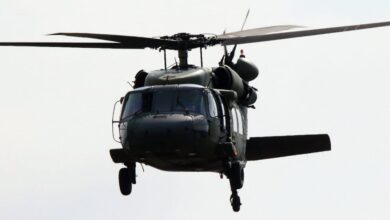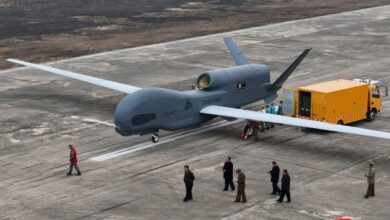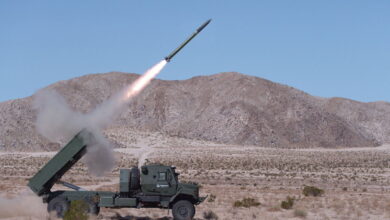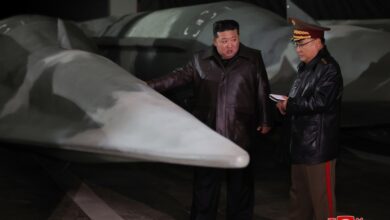
Pyongyang has become more fixated and strident on offensive nuclear capabilities.
In September, it passed a nuclear policy law that enables preemptive nuclear strikes against real or perceived threats, a dramatic departure from its previous insistence on self-defense.
In early November, one of its short-range ballistic missiles landed 26 kilometers (16 miles) south of the inter-Korean sea border, an unprecedented escalation since the two Koreas’ partition.
Yet, South Korea’s missile capabilities are inadequate for the North’s increasingly hostile and sophisticated nuclear arsenal. All three pillars of Seoul’s missile deterrence are riddled with holes.
South Korea’s Missile Defense
Its defensive leg, Korea Advanced Missile Defense (KAMD), consists of early warning systems and interceptor missiles.
Meanwhile, Kill Chain and Korea Massive Punishment and Retaliation (KMPR) form its offensive fronts. The first predicts the imminence of nuclear attacks and carries out preemptive strikes, while KMPR promises to strike and remove the North’s regime in case of the South’s subjection to nuclear or conventional attacks.
However, the efficacy of this defense posture has come into doubt.
Consider KAMD. The air force recently bungled the firing of Patriot missiles, a long-range anti-ballistic, anti-aircraft missile system. While responding to the North’s relentless missile provocations, it canceled the second Patriot launch when the fire control system flagged a fault. The missile in question was PAC-2.
Although Seoul has been transitioning to and purchasing more PAC-3 MES, an advanced version with hit-to-kill capabilities and enhanced maneuverability against ballistic and cruise missiles, it’s unclear whether the military can handle the new outfit.
Since its 2014 introduction to South Korea’s military, it has never been tried and tested on Korean soil due to a Seoul-Washington agreement that restrains South Korea’s live-fire drill involving the model. The mishandling and inexperience call into question the military’s capability to timely respond and fend off incoming missiles.

Shortcomings of THAAD, Cheongung Missiles
Another US-made defense system in South Korea is the Terminal High-Altitude Area Defense system (THAAD). Yet, its interceptive range of 124 miles (200 kilometers) and its location in the southern part of South Korea leaves bare over half of South Koreans, who live clustered around Seoul, and almost all active-duty formations operating near the inter-Korean border.
Compensating for THAAD’s and Patriot’s impotence against missiles darting at lower altitudes and higher speeds, Korea’s medium-range surface-to-air missiles (KM-SAM), or Cheongung, cover the lower-tier gap.
For its omnidirectional and multi-layered coverage against long-range artillery, Cheongung-II nailed South Korea’s second-largest military export deal in history in January.
Recently, however, the missile exploded shortly after firing due to poor radar communications.
Flawed Offensive Capabilities
As missile defense flounders, South Korea’s compromised offensive capabilities further erode deterrence.
When Pyongyang lobbed a ballistic missile over Japan in early October, Seoul fired its home-grown short-range Hyunmoo-2C ballistic missile toward an exercise target off the eastern coast.
Intended for precision strikes with its enhanced range, the Hyunmoo series has long formed the backbone of Seoul’s Kill Chain strategy. However, within seconds, the missile nozzle veered abnormally, flew in the opposite direction, and crashed into the base.
KMPR seems feckless, too. It threatens retaliation against the North using precision-guided munitions, and the air force comprises the strategy’s core conduit.
Yet, following the Patriot debacle, the air force failed to discharge one of two Spice-2000 air-to-surface guided bombs due to targeting errors. Another flight tagging behind tried to shoot two SLAM-ER, an air-launched land attack missile, but one of them failed due to loading errors.

Slinking Stockpiles
Making matters worse, South Korea’s missile stockpiles are paltry.
South Korea’s Air Force’s entire Joint Direct Attack Munitions range will be depleted in less than two weeks into war. These are bombs converted into precision-guided munitions to bust the North’s battery and bunkers. Meanwhile, Patriot missiles for air defense will also all be spent in about two weeks.
Missile drills from October to the present indicate that the success rate is only 45 percent. Given the insufficient munitions reserve, South Korea can field just about a week’s worth of missile attacks and defense against the North. Simultaneously and afterward, the United States Forces Korea will have to do most of the heavy lifting.
North Korea’s Expanding Arsenal
On the other hand, Pyongyang continues to develop ever-sophisticated weaponry.
Its tactical guided weapons are capable of evasive maneuvers to skirt interception. Even if missiles are successfully launched, preemptive “surgical” strikes to neutralize the North are fraught with intelligence and accurate targeting difficulties.
Pyongyang’s launching platforms have diversified as well, such as from reservoirs and submarines. Its “blending” of hypersonic and cruise missiles and multiple rocket launchers further compounds calculating their trajectory.
As North Korea expands its arsenal based on solid fuel, which requires a shorter launching time compared to liquid fuel, South Korea faces more detection and response problems.

Increasing Drills, Timely Procurement
Hence, South Korea’s immediate concern should be to conduct more missile drills. Apart from responding to the North’s provocations, Seoul has shied from regularly testing its missile capabilities for fear of goading Pyongyang.
Yet, only peacetime drills can pinpoint and redress Seoul’s missile problems. The consequence of encountering hiccups and flapping in wartime is too grave.
Timely procurement of enough precision-guided munitions and defense missiles is also crucial. These high-technology weapons take years to order, produce, deliver, and deploy.
South Korea should coordinate and secure large stockpiles within the next few years to counter the North’s increasing number of nuclear warheads.
Since many missiles go outdated or constantly require retrofitting to meet evolving missile challenges, Seoul should devise a detailed plan to procure munitions in tranches.
Considering Other Options
Longer down the road, South Korea needs to consider other nuclear options. For now, Seoul and Washington should kickstart the process of allowing the former to develop and deploy its own nuclear-powered submarines (SSBN) capable of launching ballistic missiles.
When North Korea can pose serious area denial with its anti-ship missiles, these submarines can evade detection and effectively mount retaliation.
Besides the timely deployment of indigenous SSBNs, the navy should bolster its overall capabilities. Seoul recently allocated a budget to procure ship-launched anti-ballistic SM-3 missiles, which can intercept missiles at higher altitudes than THAAD.
This is a commendable step but hardly enough. A congressional audit found that the navy’s SM-2 interceptor missiles miss targets 30 percent of the time, which underlines the importance of frequent drills involving high-tech weapons.

Strategic Assets
In time, Seoul should also consider weaning itself off relying on Washington’s promise of deploying more US strategic assets such as bombers, aircraft carriers, and nuclear submarines capable of delivering nuclear weapons.
During a meeting last month, US and South Korean defense ministers pledged to deploy such strategic assets to the Korean peninsula with “increased frequency and intensity.” Though necessary to convey Washington’s stronger commitment to extended deterrence for its allies, strategic assets are not the panacea to the North’s browbeating.
The logistics and politics behind deploying strategic assets are fickle. One US carrier strike group’s dispatch to and exercise around the Korean peninsula consumes almost $37 million each time. One B-2 bomber’s trip to the region sets Washington back by around $4 million. The exorbitant bill was why Washington balked at Seoul’s request in 2016 for a regular deployment of strategic assets.
Seoul-Washington relations had soured before over who should foot the bill for these guzzlers. Although the Biden administration has been more at ease with deploying them, the decision over future deployments eventually depends on whoever takes the helm in the oval office.
Just as the Western support for Ukraine hinges on political will and economic circumstances, so the snowballing fees of strategic assets can be a sticking point again in the future.
The scale and frequency of Pyongyang’s provocations keep increasing, which will require more budget allocations for more strategic assets to be diverted to the area. We can’t rule out the sort of cynicism of former US President Donald Trump rearing its head again and threatening to leave Seoul to its own devices.
Indigenous Nuclear Weapons Program
Pyongyang’s unabashed missile provocations and Seoul’s increasing vulnerability have led the majority of South Koreans to call for an indigenous nuclear weapons program.
Indeed, Seoul’s nuclear armament poses numerous domestic and international challenges, from securing testing grounds and waste disposal sites to exiting the Treaty on the Non-Proliferation of Nuclear Weapons and revising the Washington-Seoul Civil Nuclear Cooperation Agreement, which regulates nuclear fuel processing.
Diplomatic and military risks arising from China’s and Russia’s reactions will be immense, too. However, as Seoul hauls its conventional missile capabilities, all future options should be open to debate.
After all, real deterrence derives from real capabilities, not just renewing verbal and materialistic commitments.
Eunwoo Lee is a non-resident research fellow at the Korea Nuclear Strategy Forum. He served at South Korea’s Ministry of National Defense, on detachment to the Army Headquarters. He has written extensively on South Korea’s domestic and international affairs for The National Interest, The Diplomat, The Japan Times, 9DASHLINE, Inkstick, and others.
The views and opinions expressed here are those of the author and do not necessarily reflect the editorial position of The Defense Post.
The Defense Post aims to publish a wide range of high-quality opinion and analysis from a diverse array of people – do you want to send us yours? Click here to submit an op-ed.











